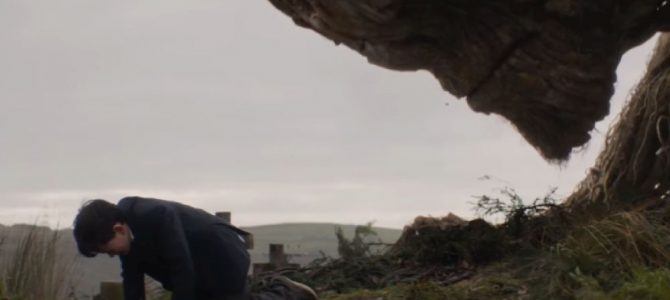
Never make movies for book lovers. I know, because I am one, and I can tell you from experience that book lovers are the toughest crowd you’re ever going to get for any adaptation. They don’t care about your big ideas, and they don’t want anything reimagined or reinvented. They simply want to see the story they love faithfully reproduced onscreen. The most common critique of movies adapted from beloved novels is often the simplest and most crushing: “The book was better.”
That won’t be the case with the movie adaptation of “A Monster Calls,” although the book is better. Readers who cried their eyes out at the allegorical 2011 best-selling young adult novel will be pleased with what they get from the movie. Or they’d better be—the whole thing is seemingly made for them alone, a word-for-word duplication, with many of the scenes in the movie reproduced verbatim.
This is undoubtedly because the author of the book also wrote the screenplay for the film. His name’s Patrick Ness, and he wrote “A Monster Calls” based on the story ideas of his late friend Siobhan Dowd, who had terminal cancer when she began the book and died before she could finish it.
It’s a beloved book, the first and only one to win both its author and illustrator (Jim Kay) the Carnegie and the Greenaway Medals, respectively. Both are prestigious honors among the British publishing set. Although it’s a bit hackneyed and overbearing, the book is a powerful allegory for kids about overcoming sorrow and despair in the wake of tragedy. But not all books are meant to be so faithfully adapted, and this movie would have been well-served to avoid it.
Desperate Wishes to Revive ‘The Way It Was’
The movie tells the story of young Conor O’Malley, a boy in junior high in England whose mother, as we come to understand, is sick. It’s never spoken aloud, but she has cancer. This is a cancer movie, and it’s not subtle about it.
At first, Conor is not a very sympathetic character, like any pre-teen. He’s sarcastic and blunt; he dislikes his stuffy grandma, and resents having lived without his dad (who ran away to America for a new life and a new wife) for the last six years of his life. But he’s learned to be self-reliant, because he’s had to be, thanks to his mother’s illness. One of the ways he takes care of himself is by convincing himself that his mother is okay, that she’s going to get better, and that everything will go back to “the way it was.”
Your heart breaks for him, a little. Everyone at school treats him like he’s invisible. Parents and teachers refuse to punish him although he pushes them all to their limits, because, as they say, “He’s going through enough.”
Amid this turmoil Conor is visited by a monster (voiced with great authority by Liam Neeson). A yew tree, standing outside his family home on a nearby hill, comes alive at night and marches up to his window, demanding that Conor listen as he tells three stories. Maybe Conor’s dreaming, or maybe it’s real, but it really doesn’t matter. It’s clear from the beginning that this is a device, a look inside Conor’s dreams and nightmares, his ways of coping with his mother’s illness and the terror he feels in facing a possible, terrible outcome.
If it sounds heavy-handed, that’s because it is. The movie excises the few parts of the book that offered cheerful respites from the angst—a girl at school who tried to befriend Conor and protect him from bullies, flashbacks of Conor and his mother enjoying time together during happier times. All warmth is gone, and the remaining scenes are bleak and baleful.
Save the Didacticism
As the centerpiece of the story, young Irish actor Lewis MacDougall does a fine job, especially since he must have spent hours acting in front of a green screen. Felicity Jones is as tender as ever as Conor’s terminally ill mum, but she’s too young and pretty for the part. When she comforts Conor, she looks like his sister.
Then there’s Sigourney Weaver, who shows up midway through the movie trying out the most baffling attempt at a British accent I’ve seen on screen in a great while. While she swings and misses on moment after moment that are meant, in the book, to show young Conor that he’s not the only one who’s hurting, and that he has more in common with his grandma than he thinks, all the air goes out of the movie. While she’s concentrating too hard and stiffly enunciating all of her consonants, it’s hard to stay engaged with the emotional weight of the story.
But more baffling than Weaver’s accent is the question of who this movie is meant to be for. It’s not very young children, who would be too horrified by some of the movie’s scarier sequences, and unprepared intellectually for the descriptions of murder and vengeance in some of the monster’s tales. It’s not for teens, who would probably find the lessons heavy-handed and the mood too serious. And it’s not for parents, who would likely roll their eyes when the monster dispenses words of wisdom like, “There is not always a good guy. Nor is there always a bad one. Most people are somewhere in between.”
The book is straight allegory, teaching kids by using an imaginary tree monster that life is messy, love hurts, and letting go is hard. But the film becomes a macabre melodrama, and one that is best avoided with your family this holiday season. When this monster calls, best to let the machine pick up.









